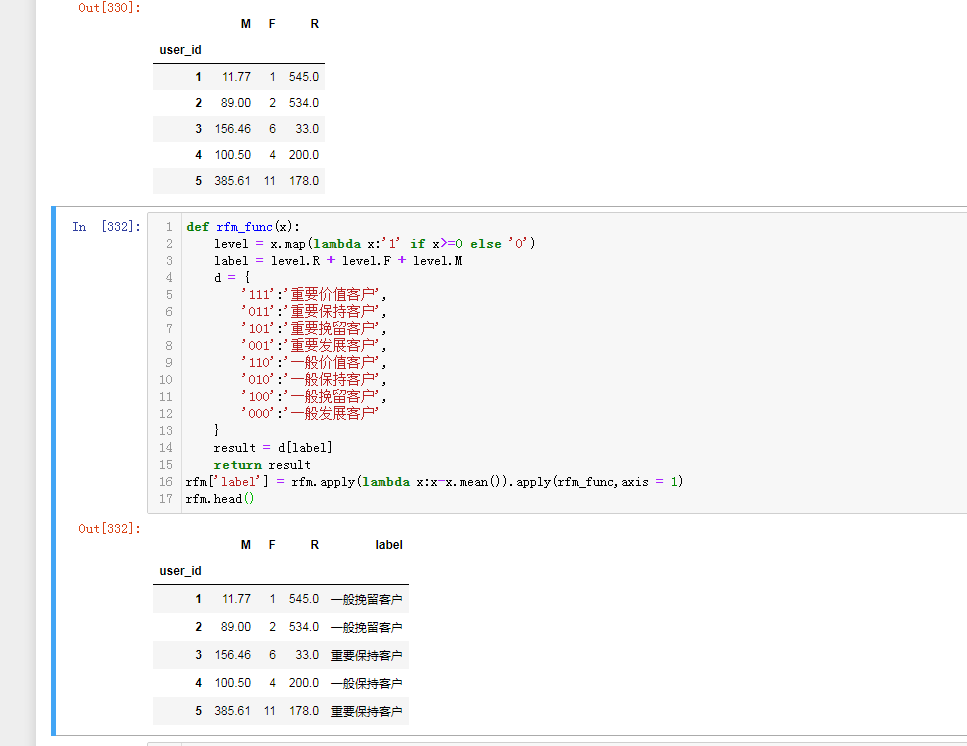RFM 模型 , 用户生命周期

def rfm_func(x): level = x.map(lambda x:'1' if x>=0 else '0') label = level.R + level.F + level.M d = { '111':'重要价值客户', '011':'重要保持客户', '101':'重要挽留客户', '001':'重要发展客户', '110':'一般价值客户', '010':'一般保持客户', '100':'一般挽留客户', '000':'一般发展客户' } result = d[label] return result rfm['label'] = rfm.apply(lambda x:x-x.mean()).apply(rfm_func,axis = 1) rfm.head()

### 第五部分:用户的生命周期 - 将用户划分为活跃用户和其他用户 - 统计每个用户每个月的消费次数 - 统计每个用户每个月是否消费,消费记录为1否则记录为0 - 知识点:DataFrame的apply和applymap的区别 - applymap:返回df - 将函数做用于DataFrame中的所有元素(elements) - apply:返回Series - apply()将一个函数作用于DataFrame中的每个行或者列 - 将用户按照每一个月份分成: - unreg:观望用户(前两月没买,第三个月才第一次买,则用户前两个月为观望用户) - unactive:首月购买后,后序月份没有购买则在没有购买的月份中该用户的为非活跃用户 - new:当前月就进行首次购买的用户在当前月为新用户 - active:连续月份购买的用户在这些月中为活跃用户 - return:购买之后间隔n月再次购买的第一个月份为该月份的回头客
# 统计每个用户每个月的消费次数
user_month_f = df.pivot_table(index='user_id',columns='month',aggfunc={'user_id':'count'}).fillna(0)
# 统计每个用户每个月是否消费,消费记录为1否则记录为0
df_purchase = user_month_f.applymap(lambda x:1 if x>0 else 0)
df_purchase.shape # (23570, 18)
#将df_purchase中的原始数据0和1修改为new,unactive......,返回新的df叫做df_purchase_new
#将df_purchase中的原始数据0和1修改为new,unactive......,返回新的df叫做df_purchase_new #固定算法 def active_status(data): status = []#某个用户每一个月的活跃度 for i in range(18): #若本月没有消费 if data[i] == 0: if len(status) > 0: if status[i-1] == 'unreg': status.append('unreg') else: status.append('unactive') else: status.append('unreg') #若本月消费 else: if len(status) == 0: status.append('new') else: if status[i-1] == 'unactive': status.append('return') elif status[i-1] == 'unreg': status.append('new') else: status.append('active') return status pivoted_status = df_purchase.apply(active_status,axis = 1) pivoted_status.head()
out:
user_id 1 [new, unactive, unactive, unactive, unactive, ... 2 [new, unactive, unactive, unactive, unactive, ... 3 [new, unactive, return, active, unactive, unac... 4 [new, unactive, unactive, unactive, unactive, ... 5 [new, active, unactive, return, active, active... dtype: object




